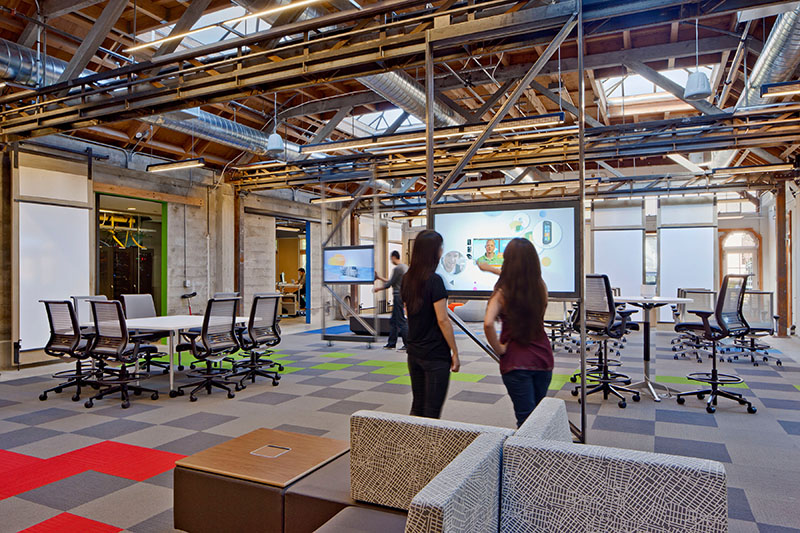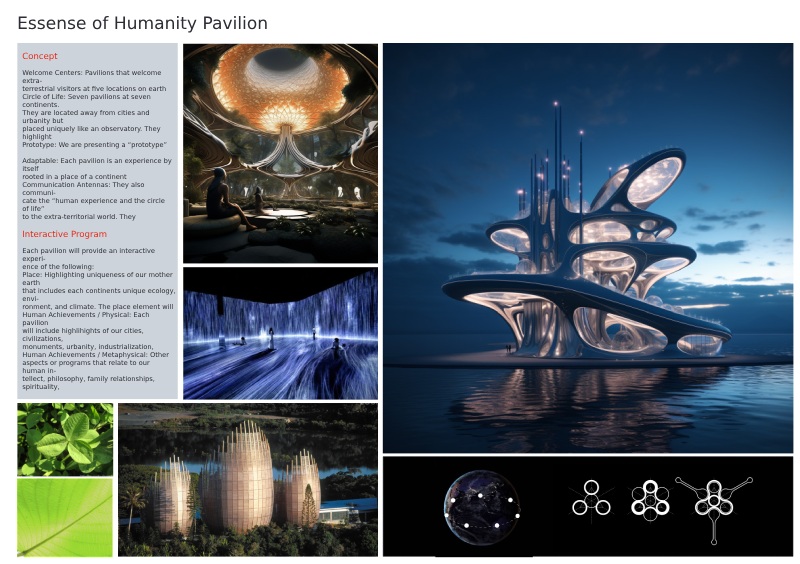AI and Design
I have a confession to make: AI helped me to write this article. Can you blame me?
Stumped for an interesting lead (or lede, if a journalist purist), I turned to my months-long friend ChatGPT for suggestions. I asked, “What are some metaphors for artificial intelligence?”
This query seemed to perplex ChatGPT. Maybe it was having a bad day. But, more likely, I didn’t ask a precise-enough question. Its sweet little ellipses just kept dot-dot-dotting like someone drumming fingers on a desk. Well, my real fingers were drumming too. After five long seconds and my patience wearing thin, ChatGPT produced this: “Metaphors for artificial intelligence can help explain complex concepts by drawing parallels to be more familiar or relatable –”
That’s where I hit the “stop generating” button.
“My bad,” I politely typed, “apparently, I didn’t give you the right prompt. Try this instead: ‘What are some examples of metaphors that describe artificial intelligence?’”
In a jiffy, ChatGPT replied: “AI as a Brain, AI as a Toolbox, AI as a Detective, AI as a Teacher, AI as a Personal Assistant, AI as a Chess Grandmaster, AI as a Mimic, AI as a Doctor, AI as a Driver.” (Hmmm, someone needs to tell ChatGPT the difference between a metaphor and a simile.)
I noticed that nowhere on the list was “AI as a Designer” or “AI as an Architect.” Perish the thought, right? Or, gads, perhaps this was an AI oversight? Which led me to asking: “Will AI replace human architects and designers?”

I received a somewhat reassuring response: “AI has the potential to significantly augment and enhance the work of human architects and designers, but it is unlikely to completely replace them.”
My digital friend went on to offer in three seconds flat seven solid reasons why A&D humans are needed – “Creativity and Innovation, Context and User Needs, Collaboration and Communication, Ethical and Aesthetic Judgments, Unpredictable Challenges, Emotional and Psychological Factors, and Cultural Sensitivity” – along with a mini-essay elaborating on these points.
Next, I got to the crux of this article and asked ChatGPT: “How are architecture and design firms using artificial intelligence or see it as a tool for the future?”

The response: “Architecture and design firms are increasingly recognizing the potential of artificial intelligence (AI) as a valuable tool for the present and future of their industry. Here are some ways in which AI is being used and viewed as a tool in architecture and design … ”
ChatGPT then proceeded to write my article for me. But there were a few problems: ChatGPT’s content as of now is only as current as September 2021, and only as objective as its algorithm recipe and as accurate as its massive stew of ingredients. And, as much as I appreciated the well-structured and succinct response, ChatGPT’s information sounded, well, artificial, boring and bland. It needed some spice. (You can read ChatGPT’s version of this article in the sidebar below.)
So, I needed to hear from some humans.
The Elephant in the Room: Do Humans Think AI Will Take Our Jobs?
When AI design platforms like DALL-E, Midjourney and Stable Diffusion launched over a year ago, I imagine there was much nail-nibbling among designers, kind of like ChatGPT and similar have made writers wonder if we’re soon to be cast into the dustbin. We’re not crazy: AI was a factor in the recent Writers Guild of America strike.
And we’re just on the cusp of a market explosion: The AI industry is expected to grow twentyfold by 2030, according to Statistica. But discussions about AI with people in the A&D, tech and office furniture communities (not to mention my own experiences with AI over the past several months), have convinced me – at least for now – the worry is for naught and, in fact, that these incredible tools are helping to elevate human output.
One of the A&D leaders that I had a conversation with is Nena Martin. “All the big firms think it’s just a matter of time before AI is officially deployed,” the Austin-based interior design principal with DLR Group told me. “Our firm sees AI as an important tool that can accelerate the initial design process and offer endless solutions. It is an effective and evolving platform that extends the designer’s ability during the iterative phases of any project. It is a wonderful partnership that needs to be embraced.”
To encourage the use of AI technology and get people comfortable with its capabilities, DLR Group held a “Design Days” charrette in July that engaged many employees from the 1,500-person firm in an AI project challenge. The humans used various AI platforms to develop a suite of design solutions, including site plans, architectural drawings and 3D renderings for a client. (Check out a video montage of DLR Group’s 2023 Design Days.)
I also talked with Christian Lehmkuhl, a Dallas-based architect and design director with Gensler. He told me that while AI will become an integral part of the firm’s work, it won’t supplant the core creative design process.
“People started using AI, saw that it could make pretty images, and then worried that it would replace the designer. Well, it really can’t because the design process is much bigger than creating images. Design starts with creating experiences, and the visual aspect follows,” said Lehmkuhl. “While AI can quickly generate a lot of ideas, enhance storytelling and analyze data, AI complements the creative process rather than replaces it.”
I then turned to Ryan Anderson at MillerKnoll for his take. The Zeeland, Michigan-based vice president of global research and insights, who has been tracking tech trends since the 1990s, doesn’t believe AI will ever oust human designers.
“We should understand AI as a powerful tool in the hands of a designer – not a replacement for a designer,” Anderson said. “AI can take away the rote, mechanical, arduous sort of work where humans often make mistakes and free us to do what we do really well, which is creative problem-solving – and, because of this, I think we’ll be leaning on people more than we ever have.”

Open Source or Owned or in Between?
Major concerns with open-source AI platforms include content custody, ownership and attribution, not to mention accuracy and client confidentiality. Governments across the globe are scrambling to figure it out and so are companies, of course.
Lehmkuhl said Gensler is developing proprietary AI tools, replete with Gensler’s own content, to avoid legal quagmires and protect its own as well as its clients’ information, and, most importantly, to give clients the pure Gensler-brand design process and experience.
As the largest A&D firm in the world by revenue, Gensler has the resources to produce such enterprise solutions. But what about smaller firms? And is using “open source or owned” a matter of funds or philosophy, or a bit of both? It’s a question each firm and person must answer for themselves.
Nena Martin said DLR Group has begun using Stable Diffusion. “Using our proprietary Revit plug-ins, we are seeing the efficiencies and can expect further levels of sophistication and intelligence in our deliverables,” she said.
Shawn Calvin, director of interior design with INFORM Studio as well as owner of Detroit-based Shawn & Co., told me she’s tried several AI tools and is agnostic about which is the best. She welcomes the sharing and inspiration that open-source platforms allow. “Part of design is about learning from what’s been done previously, whether you’re using artificial intelligence or some other source for inspiration,” Calvin said.
Maria Martin, owner of Interior Design Works (no relation to Nena Martin and also based in Austin), has been using a variety of open-source AI tools since February. As the owner of a smaller firm, she appreciates how these tools are like having a posse of assistants, which she said can help to level the playing field with the big firms that have not only multitudes of human interior designers but also graphic designers, writers, public relations professionals and the like on staff.
Martin has landed on Midjourney as her favorite AI tool, which she appreciates for interior design inspiration and because it guides users in learning. She likes ChatGPT to craft text for client proposals and to pull together press releases. “The beauty of these [AI] tools are that they can assist you strategically, as if you had a large team helping you,” she said.

Discerning and Learning
I’ve mentioned a handful of AI tools. How many are out there? Because ChatGPT’s data is current only up to September 2021, I had to use search to ask this question. Top of the good-old-Google list was a blog from a company called Content at Scale, which bills itself as the world’s fastest-growing AI writing platform for SEO marketers. According to Content at Scale: “The AI market is exploding, with thousands of AI tools being added to platforms … the total number is probably in the hundreds of thousands.”
Second on the search list was a blog published in Nerd for Tech that said, “2023 is a surprising year for Artificial Intelligence with almost 7,000 tools and still counting.” Really want to go down a rabbit hole? Check this out: https://theresanaiforthat.com/.
Of course, many AI platforms have nothing to do with the A&D world – and, fortunately, there are A&D peers and other professionals to guide us through the myriad AI choices that do. ThinkLab, which specializes in research for the interiors industry, recently sat down with INFORM Studio Director of Design Eric Klooster and Premier Senior Design Director Abby Shehan; the fruits of the conversation produced their recommendations (as of Oct. 6, 2023) for the Top 5 AI Tools for Design Firms.
In the coming year, ThinkLab plans to host online seminars featuring designers who are working with various AI solutions. “Connecting designers to learn from one another is going to be key to staying ahead with what’s out there, what you should invest in, and where you should spend your time,” said Jessica Jenkins, a member of ThinkLab’s research and content development team.
Mike Potoka, the technology manager for AMDG Architects in Grand Rapids, Michigan, told me about Autodesk University’s plethora of courses related to AI, which the firm plans to take advantage of. I checked out AU’s online catalog, plugging “artificial intelligence” into the search, and there is no shortage of options for learning. Also, professional associations such as AIA have started offering AI-related educational opportunities.
And then there’s tackling AI with the help of an IT guy. Minneapolis-based Jason Lund has been helping interior designers and commercial furniture dealerships for more than 15 years – at Atmosphere Commercial Interiors, as the owner of Plaid Anvil Consulting and now at CIT.
Calling himself “vendor and manufacturer agnostic,” the virtual CIO and technology advisor helps companies to pinpoint problems and identify hardware, software and service solutions.
“Users can be overwhelmed with the sheer number of choices. AI-powered tools that can winnow seemingly infinite options to a designer’s preferences and goals, early in the process, can help the designer to focus, which makes for more efficient use of their time when specifying solutions, and reducing ‘churn’ or revisions,” Lund said.
He added that AI-driven image generation will massively reduce the labor investment required of designers to generate the high-quality renderings that help clients with finalizing their buying decisions.
Parametric software such as those produced by Configura and Cyncly (parent company of 2020 Technologies) have helped designers for a couple of decades now with managing the complexities of specifying commercial furniture and kitchen and bath spaces. AI could take these solutions to a whole new level.
I asked Configura and Cyncly about their plans. Vice President of Technology Thomas Engström said Configura will be implementing AI-based components within its existing software that might include using natural-language processing models to act as an interface between users and the software, as well as machine learning that predicts and provides the next suitable action or product.
“Listening to our users and empathy for their needs is helping us navigate toward the areas [of our software] that could be improved by AI technology,” Engström said. (You can read more about his thoughts on AI in this blog post.)
Cyncly sees AI as an opportunity to deliver new sources of value to the industry and is actively developing AI solutions for project inspiration, design and sales. “We’re differentiating by going deep, instead of broad, with industry-specific applications integrated into digital processes rather than general-purpose tools,” said Gordon Bartels, general manager for kitchen, bathroom and furniture retail solutions. (Learn more about Cyncly’s plans for AI in this news release.)
Integrating AI
Lehmkuhl believes AI’s greatest strength lies in its predictive analysis capabilities. “When harnessed for architectural design, it opens a realm of workspace optimization possibilities. By inputting variables like building orientation, materials, local climate data and energy consumption into AI algorithms, we can generate concepts that prioritize energy efficiency and sustainability,” he said.
Taking it a step further, devices embedded with AI technology will be incorporated into the built environments of the future. Sure, AI is already in many homes (Alexa, Google Assistant, etc.). But what’s coming will be Siri on steroids. AI facial-recognition devices that welcome employees into buildings. AI sensors that improve workspace personalization, utilization and comfort. AI whiteboards that transcribe scribbles, notes, ideas.
I asked Lehmkuhl if he could share examples of buildings that have gone full-on “The Jetsons” (metaphorically speaking), and he said that commercial spaces aren’t quite there yet.
“The market is still evolving, and there’s a degree of hesitancy due to the lack of established solutions. More innovative companies are showing interest in distinguishing themselves, but the overall demand is not yet universal,” he said.
You can read more about Lehmkuhl’s thoughts on How AI is Transforming Workplace Architecture and Design, although he cautioned me that he wrote the article way back in the Dark Ages of June, so some of the content may be dated.
And I bet I’ll be writing about the new AI-infused headquarters for Spacely Space Sprockets a lot sooner than most of us can imagine. If you weren’t a child of the 1970s, ask ChatGPT what I mean.
Editor’s note: Molly Klimas is a writer and cheerleader for the A&D and commercial furniture communities.



